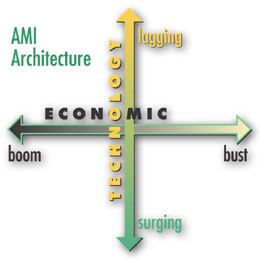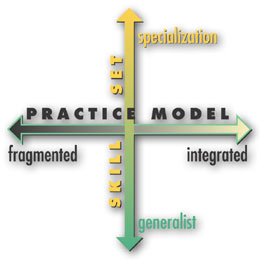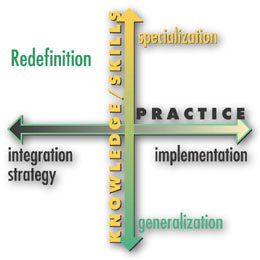

by Richard W. Hobbs, FAIA
Resident Fellow, Marketplace Research and Trends
The concept of "triangulation" in research—using several methods to study the same question—is particularly important when research involves human beings. As Ken Friedman, PhD, associate professor and director of the Nordic Center for Innovation, Norwegian School of Management, Oslo, tells us, using variations of content analysis reveals patterns and clues to what should be studied more closely. Analyzing patterns often reveals surprising issues, many of which might have gone unobserved, submerged in the subject content. Only an amalgam of content through observation, interview, and feedback allows one to make sense out of the data.
We're applying a triangulation process on the Redefinition scenario as we explore and expand the matrix outlined in this column. Input from all angles will help all who use it to choose and support an individual development strategy for themselves or their firms. (See January and March AIArchitect articles.)
 We
gained some great insight for the redefinition research from the facilitated,
open discussion at last fall's Point Break Symposium. Its examination
of marketplace, value, and knowledge defined a framework for exploration
and scenario development. Some of the main discussion points at Point
Break were:
We
gained some great insight for the redefinition research from the facilitated,
open discussion at last fall's Point Break Symposium. Its examination
of marketplace, value, and knowledge defined a framework for exploration
and scenario development. Some of the main discussion points at Point
Break were:
• The architect as thought leader
• Knowledge-based architecture versus practice-based architecture
(beyond the profession as it exists)
• How the value of architecture services is disconnected from compensation
• The value of leadership, which is a social responsibility
• The notion of architects as diverse, capable, and already performing
in an ARCHITECTURE future beyond an architect's future.
Aligning with the
process
Point Break's moderators helped shape the discussion. For instance, Tom
Fisher, Assoc. AIA, said that the profession and the academy are out of
sync with the economy. They are still aligned with the product and not
necessarily the process, while the product of design is still the measure
of architectural culture. Attempts to align with the process lead to specialization,
he posited. Yet, does specialization work against the inherent value of
the design process and the architect's role as coordinator of specialties,
as facilitator and integrator?
Fisher believes that many markets are eager for design thinking. In providing this type of thinking, architects must be responsible for the total approach, which includes work "upstream" and "downstream" along the continuum of the building cycle (see diagram). They also must maintain an architect's identity when bringing other disciplines into the process. Many cycles of the process are virtual and nonphysical and should be embraced and approached with the same rigor and passion as the physical, Fisher says.
 Synthesizing
through the design process
Synthesizing
through the design process
Steve Polo, AIA, OP-X Partners, promotes a strategy that uses the training
and skill gained through architecture education to enhance value for the
client by applying the design process for all decisions made in any business.
The end result is not necessarily a building! He states that the architect
is uniquely, broadly qualified to bring together many parts into a whole
system—it does not matter what the "it" (the final result)
is. Polo sees an emerging vision of the architect as holistic, synthesizing
thinkers who bring value to any "it." This architect sells experience,
not built space.
Architects in the future will have a better understanding of modern business skills and will be able to translate them into value for the client. The messages of Fisher and Polo are consistent in this: We must apply critical thinking to defining our own identity. To help you in this exercise, enter the community dialog of the Point Break Symposium. Use this reference as you choose, (link)
A rich gumbo of ideas
Here are some more ideas for the redefinition pot:
Growing complexity:
Daniel Cappella in the May 2000 issue of DOMUS
magazine commented on two trends: growing complexity in everything we
design and the accelerating transformation in the economy from products
to services. Clients told him they were reluctant to involve architects
in defining a solution, because architects seemed to be incapable of working
in the multidisciplinary teams that complex projects demand. Cappella
said the architects seemed stuck in an out-of-date obsession with objects
at the expense of processes and services. He is confident, though, that
this is changing; that architects younger than 35 and students are comfortable
in dealing with service design and future scenarios. Most significanly,
architects are taking lead roles is new-generation companies (Scient,
Razorfish, Frog Design, Sapient, and RareMedium, to name a few.)
Architects? Yes.
Design process? Yes.
Buildings? Maybe—but not always.
 AIA
ad program: The current research effort for the 2003 AIA advertising
program, under the direction of AIA Communications Managing Director Chuck
Hamlin, entails extensive interviews with CEOs and the vice presidents
of real estate of client firms. Through this process, the AIA is learning
about clients' issues, their work processes, and their expectations of
architects. The results of this research will be introduced to AIA members
at the AIA convention in May. We subsequently will introduce the findings
into the Redefinition scenario and interpret it with an eye toward aligning
client perceptions/realities to the architects' self-positioning on the
matrix. We're hoping, too, that it will help architects in their own strategy
development.
AIA
ad program: The current research effort for the 2003 AIA advertising
program, under the direction of AIA Communications Managing Director Chuck
Hamlin, entails extensive interviews with CEOs and the vice presidents
of real estate of client firms. Through this process, the AIA is learning
about clients' issues, their work processes, and their expectations of
architects. The results of this research will be introduced to AIA members
at the AIA convention in May. We subsequently will introduce the findings
into the Redefinition scenario and interpret it with an eye toward aligning
client perceptions/realities to the architects' self-positioning on the
matrix. We're hoping, too, that it will help architects in their own strategy
development.
Innovative service survey: The AIA also is undertaking a Survey of Innovative Service Models, now being completed via email by selected AIA members.
More value away from the core: Susan Hensey, AIA, Little & Asssociates, applied her theory of value for the client to the matrix. Her findings show that clients receive greater value for services that are to each side of the center of the matrix, whether the service falls in the upper left or upper right quadrant. She said the further from the commodity of design, the greater the value. Try it—you can apply your sense of value within the matrix.
 Toward
design strategists: Bernhard Buerdek, designer and professor at
the Hochschule für Gestaltung, Offenbach am Main, states, "As
we see the shift from hardware to software, we can also a shift in the
last few years that has product designers moving to design consultants
and even to design strategists. By this, they have to raise their knowledge
base, which means again more research about design and design processes."
In industry, he says, we can see that designers are taking charge of marketing
and branding, to name just two areas related to design. "One reason
is that the designers are the only group in this field who are able to
visualize their ideas and new concepts."
Toward
design strategists: Bernhard Buerdek, designer and professor at
the Hochschule für Gestaltung, Offenbach am Main, states, "As
we see the shift from hardware to software, we can also a shift in the
last few years that has product designers moving to design consultants
and even to design strategists. By this, they have to raise their knowledge
base, which means again more research about design and design processes."
In industry, he says, we can see that designers are taking charge of marketing
and branding, to name just two areas related to design. "One reason
is that the designers are the only group in this field who are able to
visualize their ideas and new concepts."
Designing with people—as opposed to designing for people—makes users the subject, not the object, of innovation. Many design professionals today see that clients are asking them to take part in activities that expand the design process with a focus on context, not the object. As Miles Davis said: "Don't play what's there, play what's not there."
Pervasive trends
The April issue of Fast
Company magazine has in its "Unit of One" section
features an article titled "Advertising." It states:
• "The only way we're going to lose our relevance is if we stop
learning."
• "Emotion grabs attention and ultimately sells."
• "The advertising industry
has got to understand that it's no longer in the ad business."
• "We help build brands and a brand is the most critical asset
a company has today."
• "I want an ad agency that is creative enough to help me reinvent
my total business . . . if ad
agencies are truly in the idea business, then they need to shed the old
mentality of simply making ads."
As you read the article, imagine substituting "architecture" for "advertising."
Consider doing your own triangulation—look at your profession, firm, self, and how your are defining your scenario for the future. We plan to build on this topic throughout the year. We promise to share trends and principles, available tools that you can apply to your vision, and case studies open to your review—all for your reinvention.
Copyright 2002 The American Institute of Architects. All rights reserved.
![]()
|
Respond to the author by email. The author would like to acknowledge the research resources contributed by the Wallace Research Group |
|